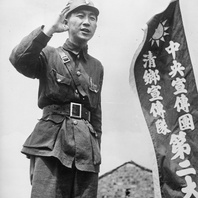
Item
Rural Pacification cadre making a speech
Photograph of a member of the RNG Central Propaganda Group’s Number 2 Rural Pacification Propaganda Team as he addresses a rural audience. The photograph was possibly produced by the RNG’s Central News Agency, which increased its capacity for photography in 1942 to compete with the propaganda work of Chiang Kai-shek’s Nationalists in Chongqing.
Read More
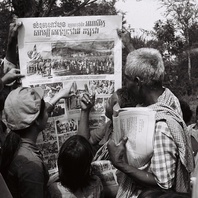
Featured Item
Villagers and soldiers pointing at poster
This (probably staged) photograph shows a group of villagers and soldiers reading an illustrated, A0-size propaganda poster celebrating the Kampuchea United Front for National Salvation (KUFNS, also known as FUNSK) [Front or Renakse]. The image provides a clear view of the poster and the photos on it. The poster’s title reads: “Fight for the Front” (or, more literally, “rush and struggle under the front’s flag”). The photos on the poster have captions in Khmer. One of the older villagers holds the upper right-hand corner of the poster. He has a folded poster in his other hand. Next to him, a young boy points his finger at the top picture, which shows the founding of the Kampuchea United Front for National Salvation in Kratie in December 1978. A female soldier points her finger at the caption below the picture. This photograph is part of the collection held by the Agence Khmère de Presse (AKP) and Cambodia’s Ministry of Information. This collection, which documents the early years of the People’s Republic of Kampuchea as photographed by the Vietnamese and a small team of Cambodian photographers, has not yet been classified or indexed.
Read More
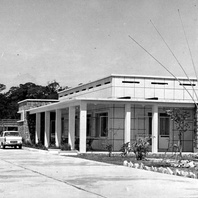
Featured Item
Motel in Sihanoukville
This modern-style motel pavilion is low, with two stone architectural elements and a seven-branch sculpture to the side. The photograph is part of the collection that was donated to the National Archives of Cambodia from the Library of the Royal University of Fine Arts by Darryl Collins and Helen Grant Ross in 2003. The collection was used by Collins and Ross for their research into urbanisation. The images were probably originally used to mount the Sangkum Reastr Niyum Permanent Exhibition at the Exhibition Hall, Bassac area, Phnom Penh. An image of the same pavilion was used to illustrate an article entitled “Discovering the Cambodian Riviera” in the monthly pictorial Kambuja no. 22 (January 1967): 44. The motel was described in that pictorial as “grand luxe” with a daily price of USD15.
Read More
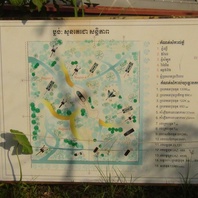
Item
Map of display of Soviet military equipment at Win-Win Monument
This photograph shows a map of the open-air display of Soviet military equipment that is located on the southern side of the Win-Win Monument complex. The Win-Win Monument complex – photographed here in January 2020 – was inaugurated in December 2018 to mark the twentieth anniversary of the end of the post-Democratic Kampuchea civil war, with the final defection of the remaining Khmer Rouge factions, thanks to the DIFID policy (“Divide, Isolate, Finish, Integrate, Develop”) also known as the “Win Win” policy of Prime Minister Hun Sen.
Read More
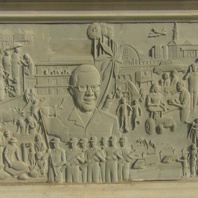
Item
Win-Win Monument bas-relief
This photograph provides a view of the bas-relief on the 117-metre-long engraved base of the Win-Win Monument. It depicts the rebirth of Cambodia after 1979 with different sectors being represented (religion, agriculture, transport, etc.). Hun Sen is featured in the middle, and is larger in sizes than other figures. The Win-Win Monument complex – photographed here in January 2020 – was inaugurated in December 2018 to mark the twentieth anniversary of the end of the post-Democratic Kampuchea civil war, with the final defection of the remaining Khmer Rouge factions, thanks to the DIFID policy (“Divide, Isolate, Finish, Integrate, Develop”) also known as the “Win Win” policy of Prime Minister Hun Sen.
Read More
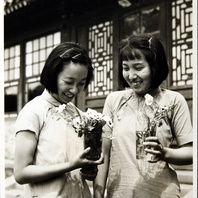
Item
Two girls picked flowers for the dinner table [sic]
From a collection of staged photographs produced under the title “Life at a Girls School in Peking”, and produced at the Peking Jiyu Gakuen in Japanese-occupied Beijing. The original caption reads: “Two girls picked flowers for the dinner table [sic]”.
Read More
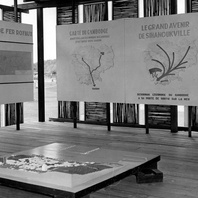
Featured Item
Sangkum Reastr Niyum Exhibition, Sihanoukville
This photograph shows maps and models on display at the Sangkum Reastr Niyum exhibition in Sihanoukville. The exhibition is displayed on a wooden platform in a room structured by half open bamboo walls. There are two maps of Cambodia on the right-hand side. The first map, with arrows from two directions pointing to Saigon, reads: “Avant 1955 [date of the construction of Sihanoukville] l’axe économique du Cambodge était dirigé vers Saigon” [Before 1955, the economic axis of Cambodia was oriented to Saigon]. The second map, with thicker arrows pointing from different directions to Sihanoukville reads: “Désormais, l’économie du Cambodge a sa porte de sortie sur la mer” [Now, Cambodia’s economy has its own sea access]. The title of the map is: “Le grand avenir de Sihanoukville” [The great future of Sihanoukville]. The photograph is part of the collection that was donated to the National Archives of Cambodia from the Library of the Royal University of Fine Arts by Darryl Collins and Helen Grant Ross in 2003. The collection was used by Collins and Ross for their research into urbanisation. The images were probably originally used to mount the Sangkum Reastr Niyum Permanent Exhibition at the Exhibition Hall, Bassac area, Phnom Penh.
Read More
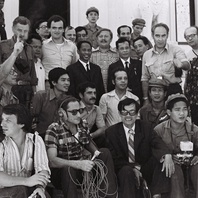
Featured Item
Soldiers and foreign visitors with Heng Samrin and Pen Sovan
This picture shows a group of soldiers and foreign visitors (including journalists) surrounding Heng Samrin (chairman of the People’s Revolutionary Council of the PRK) and Pen Sovan (Secretary-General of the Kampuchea People’s Revolutionary Party). The presence of foreign press and visitors might indicate that the photograph was taken in Phnom Penh at the time of the People’s Revolutionary Tribunal that prosecuted in absentia the ‘Pol Pot-Ieng Sary clique’ for genocidal crimes (15-19 August 1979). This photograph is part of the collection held by the Agence Khmère de Presse (AKP) and Cambodia’s Ministry of Information. This collection, which documents the early years of the People’s Republic of Kampuchea as photographed by the Vietnamese and a small team of Cambodian photographers, has not yet been classified or indexed.
Read More
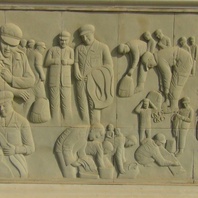
Item
Win-Win Monument bas-relief
This photograph provided a view of bas-relief on the 117-metre-long engraved base of the Win-Win Monument. It depicts the defection of Khmer Rouge soldiers to the Cambodian government. The soldiers are represented donning the uniform of the Royal Cambodian Armed Forces and sitting in rows in ceremonies organised by government officials. The Win-Win Monument complex – photographed here in January 2020 – was inaugurated in December 2018 to mark the twentieth anniversary of the end of the post-Democratic Kampuchea civil war, with the final defection of the remaining Khmer Rouge factions, thanks to the DIFID policy (“Divide, Isolate, Finish, Integrate, Develop”) also known as the “Win Win” policy of Prime Minister Hun Sen.
Read More
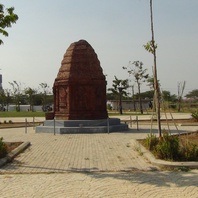
Item
Replica of Koh Ker Tower, Win-Win Monument
This photograph shows a miniature reproduction of a red-brick tower at Koh Ker (former capital of the Angkorian Empire). A garden located on the northern side of the Win-Win Monument displays several miniature reproductions of iconic Khmer monuments. The Win-Win Monument complex – photographed here in January 2020 – was inaugurated in December 2018 to mark the twentieth anniversary of the end of the post-Democratic Kampuchea civil war, with the final defection of the remaining Khmer Rouge factions, thanks to the DIFID policy (“Divide, Isolate, Finish, Integrate, Develop”) also known as the “Win Win” policy of Prime Minister Hun Sen.
Read More
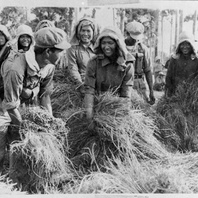
Featured Item
Soldier helping with harvest
This staged and unattributed photographs shows a soldier of the Kampuchea United Front for National Salvation (KUFNS, also known as FUNSK) [Front or Renakse] helping a group of women to harvest crops. In the foreground, the soldier, with his rifle on his back, makes a large sheaf. He looks at the woman on his left. This photograph is part of the collection held by the Agence Khmère de Presse (AKP) and Cambodia’s Ministry of Information. This collection, which documents the early years of the People’s Republic of Kampuchea as photographed by the Vietnamese and a small team of Cambodian photographers, has not yet been classified or indexed.
Read More
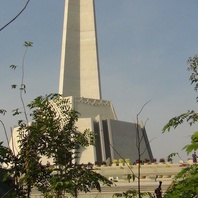
Item
Win-Win Monument
The Win Win Monument obelisk (33 metres in height) – photographed here in January 2020 – is part of a monumental complex inaugurated in December 2018 to mark the twentieth anniversary of the end of the post-Democratic Kampuchea civil war, with the final defection of the remaining Khmer Rouge factions, thanks to the DIFID policy (“Divide, Isolate, Finish, Integrate, Develop”) also known as the “Win Win” policy of Prime Minister Hun Sen.